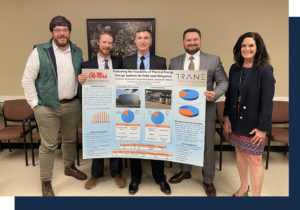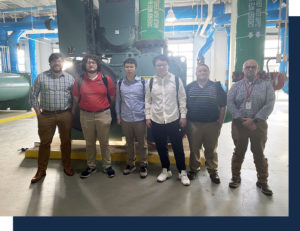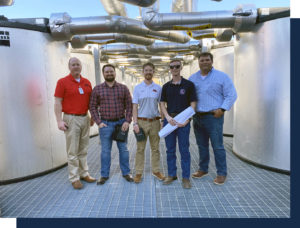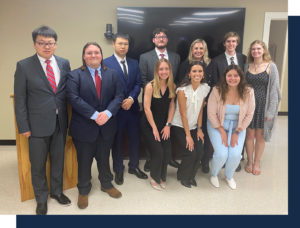Innovative Approach to “Expand” Facilities Departments
The Facilities Management (FM) department at the University of Mississippi (Ole Miss) launched a comprehensive program in the fall of 2021 to address campus infrastructure needs and energy efficiency. The university needed to replace aged-out equipment and reduce utility expenses. The innovation of this initiative was the approach of using the program to basically add an energy services team within FM. While the program has been a huge success so far, its benefits have greatly exceeded the original expectations.
With budget and staffing limitations, many institutions like the University of Mississippi lack the privilege of focus necessary to tackle a comprehensive program to address deferred maintenance and aging infrastructure in a manner that is holistic and not a “band-aid” approach. Under the leadership of Dean Hansen and Mike Dunnavant, FM desired to find a “partner” who would act as an extension of their organization, without the university having to expend funds to establish this new capability. The solution was to find this partner through the state legislation for Energy Efficiency Services (MS 31-7-14), test drive the partner-for-fit with a small project, and then move forward in a methodical manner (no more piece-meal approach) to address infrastructure needs across campus.
Legislation exists in Mississippi allowing public entities to pursue collaborative partnerships with Energy Services Companies (ESCOs) who have expertise in the implementation of comprehensive programs to upgrade facilities with a guarantee of the performance results. The Mississippi Division of Energy & Natural Resources maintains a prequalified list of ESCOs which requires inclusion on the United States Department of Energy’s pre-qualified list. Only firms on this list can submit proposals for performance-based contracting projects to public entities.

Thermal Storage Capstone Group with Nancy McBee & Jeff Cosgrove from Trane.
Ole Miss began their search by issuing an extensive 100–page request for proposal (RFP) that limited respondents to only the best of the best in the energy services industry. Ole Miss used the department of energy’s model documents for ESPC programs as a resource. The university’s evaluation committee, comprised of members from the departments of facilities management, facilities planning, procurement, and the office of administration and finance, painstakingly evaluated several responses, looking for alignment with their specific needs and an ESCO approach that mirrored their vision for the program. After a three-month evaluation and scoring period, the university selected Trane as their ESCO partner.
A Collaborative Partnership
From day one, the program was a collaboration between the two organizations built completely around Ole Miss’ specific needs in a prioritized, methodical manner. From the onset, the program was also set to be fully transparent from a pricing perspective, removing concerns over “fair and reasonable” pricing.
With 8.9 million square feet of campus buildings, the FM elected to begin with the education and general (E&G) buildings, which comprise roughly half of the university’s total square footage. In February 2022, a detailed ASHRAE Level II audit was launched on all E&G buildings.

Spirotherm Capstone Group with Jeff Cosgrove and Sam Woods from Trane.
Several months into the audit, the university was faced with the opportunity to use federal HEERF funds to make needed control upgrades to three campus buildings that were still controlled pneumatically. Due to the quick turnaround on the funding (the funds had to be expended by June 30, 2023, or they would be forfeited), Ole Miss opted to address these control upgrades under their new ESPC program, which also allowed them to select the control system of their choice rather than being forced to use a low bidder as in a typical design-bid-build project. Ole Miss was also able to hand-pick the subcontractors of their choice using this procurement model. Working closely with their ESCO partner, Ole Miss completed the controls upgrade on time and under budget. There was also the added benefit of the utility performance being guaranteed by their ESCO ($98,000 a year averaged over a 20–year term).
The second phase that the university implemented was an engineered LED lighting upgrade on all E&G buildings, which is guaranteed to reduce utility costs by $870,000/year, averaged over a 20–year term. This phase will be completed by the summer of 2024. As an extra perk of the ESCO partnership, Ole Miss Facilities Management worked with their office of sustainability to sponsor a campus-wide contest tied to this phase of the ESPC program. Students were tasked with designing digital media highlighting the environmental impact of this phase of the project. Five winners were selected, and the student designers each received an Apple iPad Pro, Apple Pencil, and a backpack made of recycled materials. Additionally, the grand prize winner from these five finalists (selected by student vote) received a $1,000 cash prize.
The environmental impact of Phase 2 included:
- Carbon Dioxide emission reduction: 5,703,303 lbs. per year,
- Sulfur Dioxide emission reduction: 85,054 lbs. per year,
- Nitrous Oxide emission reduction: 22,028 lbs. per year.

Thermal Storage Capstone Group with Dean Hansen and Chad Moore, ERG.
For the program’s third phase, the university procured 3,000 tons of cooling equipment as an addition to its chilled water loop. The university was able to select the most efficient equipment available and the specific equipment it desired by procuring the equipment under the ESPC. The new central mechanical plant will be online by spring 2025 and will be the most energy-efficient chilled water plant on campus.
These first three phases were implemented simultaneously as the ESCO completed the ASHRAE Level II audit on all other scope items. The audit produced a menu of needed projects for the university to determine which scopes they wanted to further analyze under an ASHRAE Level III Investment Grade Audit (IGA). The ESCO’s model for this phase of the program was to engage a third-party engineering firm with a specialty in energy modeling to work side-by-side with their own internal engineers. This method provides an extra level of validation and verification for the university. A team of 12 engineers began the IGA in February 2024, and the audit is slated to wrap up in December 2024. Upon completion of the audit, there will be over 260 individual scope line items for the facilities management team to evaluate and consider for implementation. How the university elects to group potential projects going forward will be completely at their discretion but will be done in a systematic manner based on their prioritized needs. In addition to the initial scopes selected, the audit will provide a five to 10-year capital plan of infrastructure needs, which will serve as a road map for the university.
In addition to facility needs and deferred maintenance, the university has also tasked their ESCO partner with evaluating several renewable energy projects. Because of the Investment Tax Credits associated with the Inflation Reduction Act, many renewable energy projects that previously would have carried lengthy paybacks can now pay for themselves in 10 years or less.
Extra Credit Points—Not Business as Usual

2022-2023 Facilities Management Capstone Student Groups.
With this new “ESCO engineering team” residing within the facilities management department, several student-related initiatives have been developed to align with the ESPC program. Students have been exposed to real-world experiences while helping to address campus infrastructure needs, and several students have had career opportunities provided by the ESCO.
The University of Mississippi department of Facilities Management has sponsored five senior capstone projects for the department of Mechanical Engineering, impacting 16 students. Each of the capstone projects was related to a specific component of the ESPC program, which was being assessed by the ESCO engineers on a parallel path with the students. At the end of the spring semesters in both 2023 and 2024, the capstone students had to present their findings and recommendations not only to their school of engineering professors, but also to the facilities management leadership team and the ESCO partner. As a direct result of working on these projects, four Ole Miss students have been hired by the university’s ESCO partner. The engineering professor who facilitated the capstone projects has shared that students are already lining up to participate on next year’s FM / ESCO capstone projects. Word has gotten out in the school of engineering that these assignments are “real world” projects that expose students to an ever-changing industry and that they can lead to promising career opportunities.
Capstone projects to date include:
- Solar PV covered parking area,
- Spirotherm versus ElectroCell for loop water quality,
- Fan wall array retrofit for Library air handling unit,
- Ice storage versus chilled-water storage, and
- Complete airside redesign of Anderson Hall.
In addition to the educational component offered to students by the ESPC Program, Ole Miss FM has also worked with their ESCO partner to implement an ongoing Lunch & Learn series for their mechanical trades team. After polling their staff on perceived needs for additional training, the FM leadership team worked with the ESCP partner to develop and conduct regular training sessions focused on their staff’s specific needs, from general HVAC operation and design to very detailed, technical training on campus-specific equipment and systems. The program has had a tangible impact on the technical understanding and capability of the FM staff, which has historically had a tough time finding relevant technical training.
A Model Worthy of Emulating
Students have been exposed to real-world experiences while helping to address campus infrastructure needs, and several students have had career opportunities provided by the ESCO.
The success of the ESPC program at the University of Mississippi has made news across the state. In addition to other universities reaching out to Ole Miss to understand what they are doing, attention has even come from the state government about the successful ESPC program. In the fall of 2023, the Mississippi Development Authority Division of Energy & Natural Resources hosted a state-wide educational webinar about Energy Savings Performance Contracting to educate other public entities on the process. The webinar brought in national experts from the National Association of State Energy Offices (NASEO) and the Energy Services Coalition (ESC) to provide an overview of how an ESPC can be leveraged to reduce energy costs and address deferred maintenance issues. A key part of the webinar highlighted an example of doing an ESPC the “right way” and producing superior results. It was no surprise that the ESPC program at the University of Mississippi was the singular highlighted ESPC program shared as a role model for others to emulate across the state.
Word of the successful program has even spread outside the state of Mississippi, and the university has been approached by numerous publications—LEDs Magazine, Tech Transfer Central, and American Builder’s Quarterly Magazine— wishing to share the “good news story” of the ESPC program at Ole Miss.
Dean Hansen, Mike Dunnavant, and Lonnie Weaver (Ole Miss facilities management leadership) closely manage the ESCO partnership with bi-weekly update meetings to ensure that all aspects of the program are on target and that the original goals of this partnership are maintained. As long as the partnership continues to meet the university’s goals with the prescribed model, the “ESCO energy engineering team” will continue to be a key part of the facilities management department.
Dean Hansen is director of facilities management at the University of Mississippi. He has a Bachelor of Science degree in civil engineering from Brigham Young University and a Master of Business Administration from the University of Texas at Austin. Dean is a registered professional engineer and Certified Education Facilities Professional (CEFP). He can be reached at [email protected].



